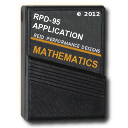The Polynomial Product Program
This program multiplies two polynomials.
Introduction
The Polynomial Product program lets you enter two polynomials, called PA and PB. The program then multiplies PA by PB to result in PC. The order of PA plus the order of PB equals the order of PC. Each polynomial is in the form:P = anxn + … a3x3 + a2x2 + a1x + a0
You must partition the calculator for at least 125 registers before running the program. PC cannot exceed 95th order, PB cannot exceed 20th order, and PA cannot exceed (95 - order of PB) order.
After the program multiplies the polynomials, you can view the coefficients of PC. PC becomes the new PA. If you elect to chain multiplications, the program prompts you for another PB, which is multiplied by the previous result. If you elect not to chain, the program prompts you for both a new PA and a new PB.
Reference
Advanced Engineering Mathematics, C. R. Wylie, Jr., McGraw-Hill Book Company, 1966.Starting the Program
To start the Polynomial Product program:- Select { *P } from the
MATHEMATICS menu.
The program displays:

- Enter the degree of the first polynomial (polynomial A) and press { dgA }.
- Press { EOD } to proceed.
The program prompts you to enter the coefficient of each term in the polynomial, beginning with the highest order term, for example:

The number shown is the order of the term to be entered. - Enter the coefficient and press { ENT }.
The program then prompts you to enter the coefficient for the next term. - Repeat step 4 until all the coefficients in polynomial A are
entered.
The program then displays the menu shown in the next section.
The Edit Menu
After you enter all the coefficients, the program displays an EDIT? menu that allows you to change any of the values.
- If you do not want to edit, press { NO } and go to the section on "Entering the B Polynomial".
- If you want to edit, press { YES } and follow the procedure listed in the next section below.
Editing the Coefficients
When you select { YES } from the EDIT? menu, the program displays the same menu that you used to enter the coefficients.
- To display the current value of the coefficient, press the [ CE ] key.
- To accept the current value and proceed to the next coefficient, press { ENT }.
- To edit the current value, enter the correct value and press { ENT }.
Entering the B Polynomial
After you enter the A polynomial and select { NO } from the EDIT? menu, the program prompts you to begin entering the B polynomial.
Using the procedures shown earlier for the A polynomial, enter (and edit, if necessary), the degree of the B polynomial and each of its coefficients.
Viewing the Results
After you enter the B polynomial and select { NO } from the EDIT? menu, the program multiplies the two polynomials and displays the coefficient of the highest order term in the result.
where the number shown is the order of the resulting polynomial.
- To display the next coefficient, press { NXT }. (When C 0 is displayed, pressing { NXT } repeats the coefficients.)
- To proceed to the CHAIN? menu (described in the next section), press { ESC }.
The Chain Menu
When you press { ESC } while a coefficient is displayed, the program displays a menu that enables you to perform chain calculations.
- To restart the program and begin a new calculation, press { NO }.
- To perform a chain calculation, press { YES }.
Performing a Chain Calculation
When you select { YES } from the CHAIN? menu, the program prompts you to enter a new B polynomial, as described in the section on "Entering the B Polynomial". The result of the previous calculation is automatically used as the new A polynomial.After entering the B polynomial, you can:
- Display the coefficients of the chained result.
- Perform an additional chain calculation.
☚ Back


